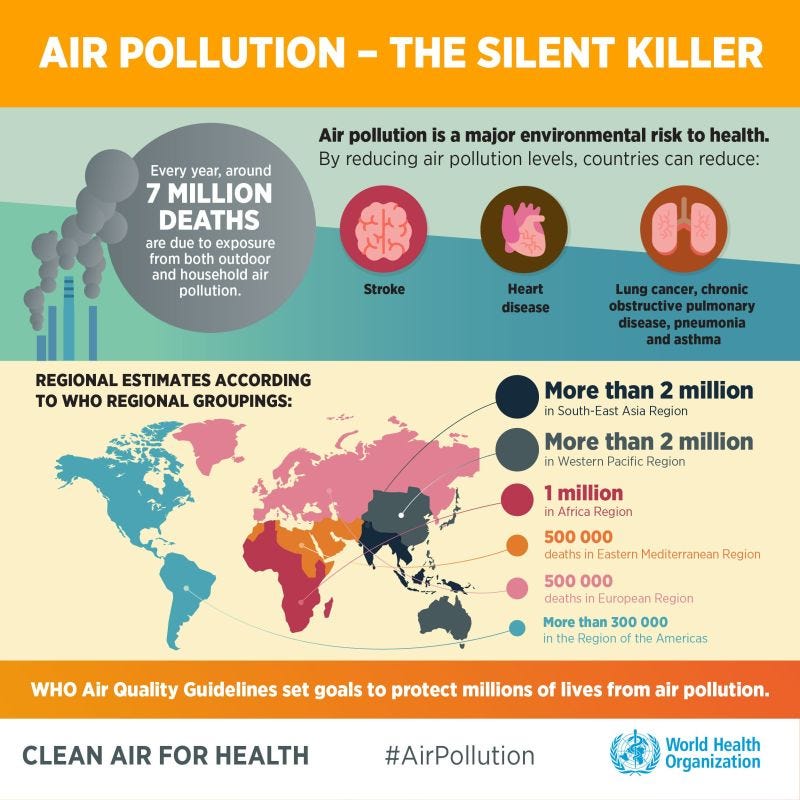health transformation institute (HTI)
Joaquim Cardoso MSc.
Chief Researcher and Editor
November 4, 2022

From smog hanging over cities to smoke inside the home, air pollution poses a major threat to health and climate across the globe.
World Health Organization (WHO)
November 2022
What is air pollution and how does it lead to disease in our bodies?
- Air pollution is the presence of one or more contaminants in the atmosphere, such as dust, fumes, gas, mist, odour, smoke or vapor, in quantities and duration that can be injurious to human health.
- The main pathway of exposure from air pollution is through the respiratory tract.
- Breathing in these pollutants leads to inflammation, oxidative stress, immunosuppression, and mutagenicity in cells throughout our body, impacting the lungs, heart, brain among other organs and ultimately leading to disease.
What organs are impacted by air pollution?
- Almost every organ in the body can be impacted by air pollution. Due to their small size, some air pollutants are able to penetrate into the bloodstream via the lungs and circulate throughout the entire body leading to systemic inflammation and carcinogenicity.
What diseases are associated with exposure to air pollution?
- Air pollution is a risk for all-cause mortality as well as specific diseases.
- The specific disease outcomes most strongly linked with exposure to air pollution include stroke, ischaemic heart disease, chronic obstructive pulmonary disease, lung cancer, pneumonia, and cataract (household air pollution only).
- There is suggestive evidence also linking air pollution exposure with increased risk for adverse pregnancy outcomes (i.e. low-birth weight, small for gestational age), other cancers, diabetes, cognitive impairment and neurological diseases.
What are some of the most important air pollutants leading to disease?
- Although there are many toxins that have adverse impacts on health, pollutants with the strongest evidence for public health concern include particulate matter (PM), carbon monoxide (CO), ozone (O3), nitrogen dioxide (NO2) and sulphur dioxide (SO2).
- Fine particulate matter are an especially important source of health risks, as these very small particles can penetrate deep into the lungs, enter the bloodstream, and travel to organs causing systemic damages to tissues and cells.
How long does someone need to be exposed to air pollution to harm their health?
- Health problems in children and adults can occur because of both short- and long-term exposure to air pollutants.
- The levels and duration of exposure that can be considered ‘safe’ vary by pollutant, as well as the related disease outcomes.
- For some pollutants, there are no thresholds below which adverse effects do not occur.
- Exposure to high levels of particulate matter, for example, can lead to reduced lung function, respiratory infections and aggravated asthma from short-term exposure.
- Whereas long-term or chronic exposure to fine particulate matter increases a person’s risk for diseases with a longer onset, like some noncommunicable diseases including stroke, heart disease, chronic obstructive pulmonary disease and cancer.
Are some populations more likely to be at higher risk for disease from air pollution?
- The children, elderly and pregnant women are more susceptible to air pollution-related diseases.
- Genetics, comorbidities, nutrition and sociodemographic factors also impact a person’s susceptibility to air pollution.
Does exposure to air pollution during pregnancy impact the health of the fetus?
- Maternal exposure to air pollution is associated with adverse birth outcomes, such as low birth weight, pre-term birth and small for gestational age births.
- A growing body of evidence also suggests that air pollution may affect diabetes and neurological development in children.
Are the health risks the same between ambient air pollution and household air pollution?
- The health impacts from exposure to ambient air pollution or household air pollution are dependent on the types and concentrations of the pollutants in the air pollution mixture to which an individual is exposed.
- However, the health risks and disease pathways between ambient and household air pollution exposure are often similar, due to their similar composition.
- Fine particulate matter for example is a common and critical pollutant of both ambient and household air pollution leading to negative health impacts.
- Additional safety risks are associated with many of the fuels and technologies used in the home emitting air pollution.
- These include burns and poisonings (from kerosene ingestion), as well as physical injury related to fuel collection, including musculoskeletal damage, violence, and animal bites.
- It is important to note that the death and disability estimates attributed to air pollution do not account for all health outcomes associated with air pollution.
- WHO estimates are likely conservative as only health outcomes for which there is strong certainty in the epidemiological evidence are included (i.e. stroke, ischemic heart disease, chronic obstructive pulmonary disease, pneumonia, and lung cancer).
Originally published at: https://www.who.int












